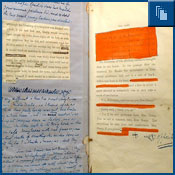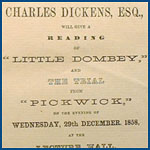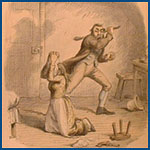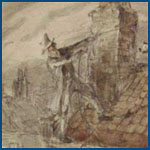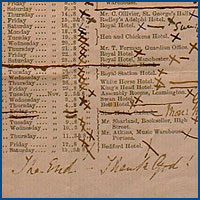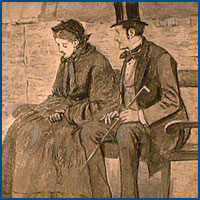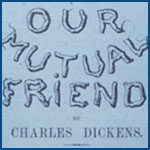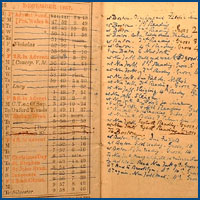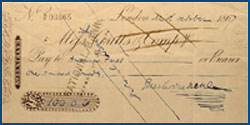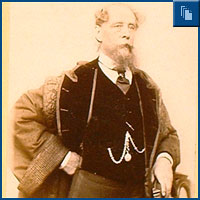|
Charles Dickens: The Life of the Author
Dickens Onstage: Up Into the Clouds TogetherOn December 3, 1844, Dickens gave a private reading of The Chimes (the second of the Christmas Books) before a select circle of friends that included Thomas Carlyle, Daniel Maclise and John Forster. It was, by all accounts, a stunning performance. The night before, he read the same work to William Macready, the famous actor-manager. "If you had seen Macready," he wrote exultantly to his wife, "undisguisedly sobbing, and crying on the sofa, as I read--you would have felt (as I did) what a thing it is to have Power." These early performances, which gave Dickens the first intimations of his overmastering power as a performer, were, as Forster would write in his Life of Charles Dickens, "the germ of those readings to large audiences by which, as much as his books, the world knew him in his later life." It has been said that the most interesting relationship of Dickens's life was his lifelong affair with the public. It was certainly the most intense. The prompt-copies Most were small editions that Dickens had privately printed specifically for use in his stage performances, each then handsomely bound up in his library binding. The only known prompt-copy of A Christmas Carol, however, was assembled by inlaying the pages of a regular edition (in this case, the 12th, published in 1849) into larger sheets, and again the whole was then bound up nicely for Dickens, and bears his bookplate. Each prompt-copy--more working manuscript than crib--served as a canvas for Dickens's brilliance as both editor and performer, the pages heavily marked up with carefully worked-out cues and stage directions, which he would eventually have memorized to perfection, as indeed he would individual readings in their entirety. There are as well numerous cuts, revisions, comments, editorial symbols, and transitional or "bridge" passages inserted in manuscript, reflecting the continuous "sculpting" of the readings as Dickens polished and tightened them so that each would achieve its maximum effect in performance. In the Carol prompt-copy, for example, one can trace the evolution of the reading, which formed a popular part of the bill from the beginning of Dickens's career on the stage in 1853, to the very last of his "Farewell Readings," in London, on March 15, 1870. An intricate network of revisions, deletions and pointers to the performer ("Weird"--"run on"--"clean over") documents Dickens's constant reworking of the text, which gradually reduced the length of the reading from three hours to a more dramatically effective hour-and-a-half.
The prompt-copy of Sikes and Nancy, the harrowing reading from Oliver Twist, is of particular interest not only because of the extensive alterations made to the printed text, but because it was the last reading prepared by Dickens before he retired from the stage. Throughout, the text and margins hold his profuse manuscript changes, deletions, additions and markings for emphasis, showing him working towards the most telling platform effects. On many pages Dickens wrote out dramatic memoranda ("Terror To The End") to help guide his interpretation during the reading, thus preserving fascinating clues to his manner of presentation on stage as well as traces of the atmosphere he strove to evoke in specific scenes. The original conclusion of Sikes and Nancy, in which Sikes slipped quietly out of the room after the murder of Nancy, seems to have given Dickens some trouble. Several friends at the trial performance, including Wilkie Collins, insisted that the reading ended too suddenly and without the poetic justice of Sikes's death provided in Oliver Twist. At first, Dickens demurred, but within weeks he was at work, newly fashioning a "fierce and passionate rush for the end," drawing primarily on material from chapter 48 of the novel. Initially Dickens had been concerned that Sikes and Nancy might strike audiences as "so horrible" that they would be frightened away from future readings altogether; but in the end, the gripping drama he crafted from Oliver Twist proved to be one of his most acclaimed performances. Dickens threw himself into the awful story with such ferocity that audiences gaped at him with fixed expressions of horror, as if he himself "had been going to be hanged." Golden fetters Dickens toured incessantly, some said compulsively, on both sides of the Atlantic for the last fifteen years of his life. In late 1857, as the tense situation of his private life was working toward the separation from Catherine that would take place the next spring, he told Forster, who always opposed the readings as beneath a great writer's dignity: "I can see no better thing to do that is half so hopeful in itself, or half so suited to my restless state." The next year he turned professional, and he drove himself relentlessly, refusing to cancel performances no matter the state of his health. (In April 1869, "half dead" with overwork and the pressures of touring, Dickens cancelled a "farewell reading" at Preston along with subsequent engagements only when his physician unequivocally ordered "instant rest.") Once on stage, "a lithe, energetic man, of medium stature," invariably with a red carnation in his button-hole, Dickens rarely glanced at the text before him, for through rigorous preparation and rehearsal he made himself, as he said, "master of the situation." He played variations on the readings, continually adding new material and even "slashing" whole sections (as one reviewer noted) on the wing; inspired both by the moment and by his profound rapport with the audience, and avoiding the mechanical repetition of effects and gestures that had scored the night before, Dickens kept each performance a miracle of freshness and invention. He did nothing by rote, he took everything on himself, and the house responded, as one American admirer said, not with applause, but with "a passionate outburst of love for the man."
During the late 1850s and 1860s Dickens published his final three novels: A Tale of Two Cities (1859), a historical novel set during the French Revolution; Great Expectations (1860-61; 1861), a mysterious and deeply affecting tale following a young man making his way in the world; and Our Mutual Friend (1864-65; 1865), a very dark exploration of the materialistic forces shaping society and the corrupting power of wealth, which has aptly been called Dickens's Waste Land. All three novels show him working with undiminished imaginative force and, if anything, even greater subtlety and artistry. Throughout the 1860s, Dickens suffered increasingly from exhaustion and poor health, and yet his drive remained remarkable, his restlessness often nearly manic. Those close to him fretted that as he amassed thousands of pounds through his lucrative public readings, he was surely shortening his life by pushing himself so recklessly. ("While engaged in these readings," G.A. Sala mused sadly after his death, "his life must have been that of a convict in golden fetters.") Yet he continued to tour tirelessly, and in the summer of 1867, America--and the riches to be made there--began to beckon. And as it had twenty-five years earlier, America again welcomed Dickens like a conquering hero when he returned to the States for a tour that stretched for more than four months, with readings continuing from December 2, 1867 to April 20, 1868. Performances averaged four evenings a week. "Well, the work is hard, the climate is hard, the life is hard," Dickens would write to Forster, "but ... the gain is enormous." A return to America
Much is packed between the tattered covers of the tiny (measuring only 2.5 x 4.5 inches) diary. The readings in England and Ireland. Dinners and evenings at the theater. The many trips from Gad's Hill to London and back, and from London to Slough (the village where Ellen Ternan lived in a small cottage at which one "Charles Tringham" called frequently). Notes on the day's weather. A footnote to the month of April reading, "N. ill latter part of this month." And then an entry on September 29, "at 12 o'k Forster and Dolby. Decide to go." The last words are heavily underscored (back from a scouting trip to the States, Dickens's manager George Dolby had pronounced the prospects very bright). Dickens had hoped that Nelly would be able to join him in America during the tour, although how he thought he could keep her hidden from the prying eyes of the American press, or even how he was going to introduce her to his many terribly distinguished American friends, is a mystery. Nevertheless, Dickens worked out a plan to bring her over with his trusted confidante H.W. Wills (and no doubt with the assistance of Forster and his sister-in-law Georgina, as well). Everything was arranged methodically and with the strictest secrecy. In his pocket diary, Dickens wrote out the coded texts of two telegrams: Tel: all well means Landing at Boston on November 19, Dickens devoted the remainder of the month to a round of dinners there with such notables as Ralph Waldo Emerson, Longfellow and his American publisher James T. Fields and his vivacious wife, Annie, who were his dearest friends in America. Thanksgiving dinner was spent at Longfellow's. In early December, the readings began. Dickens spent the month shuttling between Boston and New York (he found the railways appalling). Although he began to suffer from what he called the "true American catarrh," he kept to a schedule that would have challenged a much younger man, even managing, as the pocket diary for December shows, to squeeze in some sleighing in Central Park. Dickens opened in Boston, on the evening of December 2, 1867, with two sure-fire audience favorites, A Christmas Carol and The Trial from Pickwick. The next morning, a Boston paper reported: Mr. Charles Dickens opened his peculiar entertainment in Tremont Temple ... before as large an audience as could be comfortably crowded into that hall, in which all the poets, philosophers, sages and historians of this city and vicinity were mingled like plums in a Christmas pudding ... The entertainment is unlike anything we have ever seen in this country. It is rather a dramatic recitation than a reading, references to the book being very infrequent, and all the parts being recited with appropriate voice and action ... The audience last evening were in the best of spirits from the start ... and the first mention of well-known characters--especially Pickwick, Sergeant Buzfuz, and inimitable Sam Weller--was received with tempests of applause ... Boston had been "perfectly mad" for him, but, at least according to Harper's Weekly, New York greeted Dickens with an even greater frenzy of excitement, and scalpers did in fact have a field day. And as for Dickens, the metropolis astonished. "Everything in it," he said, "looks as if the order of nature were reversed, and everything grew newer every day, instead of older." The overwhelming demand for tickets in New York even inspired one speculator to get his hands on a proof of the tickets; he then arranged to have some thousands of them printed up, "with the intention of imposing on the public." Fortunately, George Dolby found out about the scheme when he arrived in New York to make arrangements for the tour. Indignant, he visited the printer, who, it turned out, had been duped, and who happily "broke up" his type. The forger was turned over to the police, and the fraudulent tickets destroyed. Dolby then devised his "own private stamp" with which he marked the back of each New York ticket to discourage further forgery. So successful were the first New York readings that it was announced that a second course of tickets would go on sale at Steinway Hall at 9 a.m., on December 11. However, as Harper's reported, "the throng of purchasers began to assemble at ten o'clock on the night before, and at least 150 persons waited in the line or queue all night. When the sale began not less than five hundred persons, including two women, were in the line." Although in poor health and often literally prostrate from exhaustion during the tour, Dickens, ever the trooper, refused to cancel any performances, even under doctor's orders. "No man had a right," he maintained, "to break an engagement with the public, if he were able to get out of bed." On February 23, 1912, nearly half a century after those memorable performances in Steinway Hall, the New York Sun published a touching letter from one Chauncey K. Buchanan, of Tarrytown, New York, who had been there: I heard Charles Dickens read in Steinway Hall in 1868. I accompanied my teacher ... and two or three of my schoolmates about my age, 17. Possibly the impression Dickens made on me is of interest, though I cannot recall definitely the two selections given, because since then I seem to hear his voice in every dramatic passage of his I read. 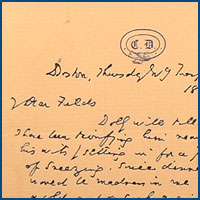 T. Fields, dated Boston, February 27, 1868, in which he tells his friend (and American publisher) that it would be "madness" for him to go out after that night's reading (he has been suffering from a terrible cold). NYPL, Berg Collection The American trip was a colossal and very gratifying success, netting Dickens, it is estimated, a truly staggering £20,000; but he was ill much of the time and he was very homesick, far from all he loved. On Christmas Eve, Dickens wrote to Wills, enclosing a letter to his beloved Nelly, which Wills was to forward to her in Italy. "I would give £3,000 down (and think it cheap)," he told Wills, "if you could forward me, for four and twenty hours only, instead of the letter." Of the correspondence of Dickens and Ternan, not a shred has survived. Dickens returned to England in May 1868 with plans already in the works for a new series of readings. It was now that Sikes and Nancy began to take shape, the coup de théâtre that would shock audiences and send Dickens's pulse skyrocketing.
|
||||||||||||||
